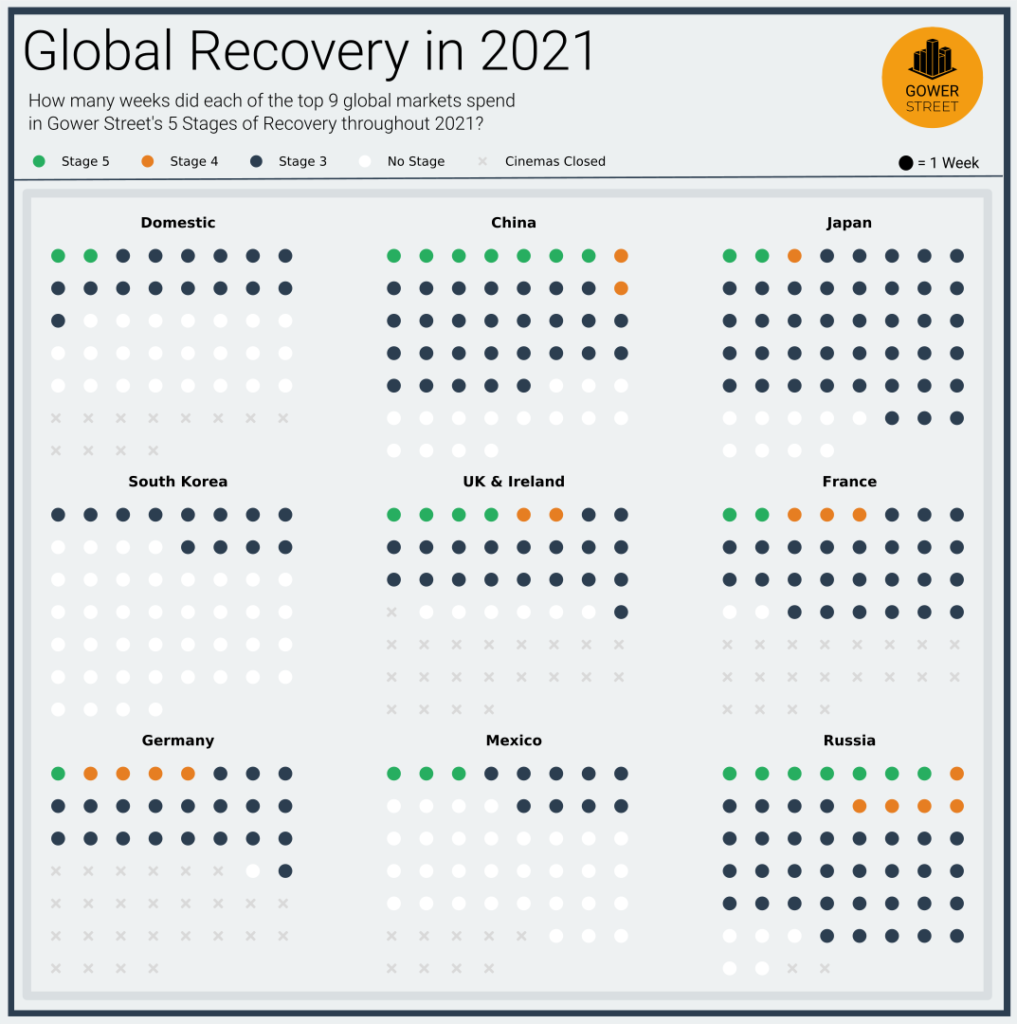The global box office recovery has progressed at an accelerating speed and value over the last two years. 2021 was a huge step forward with a global box office increase of 78% on 2020 to approximately $21.4 billion. Numerous movies achieved results that were at least as good as in pre-pandemic times. All-time records have been broken on territory, regional and global levels. Nevertheless, there is still a significant gap compared to the last three pre-pandemic years. 2021 came in 48% below the average box office of that period.
How has the recovery developed in 2021 in individual markets? Are there differences in the level, sustainability and timing of progress? As part of Gower Street’s review of 2021 we are looking to answer those key questions. We concentrated on nine top territories that accounted for, on average, nearly three quarters (73%) of global box office in three pre-pandemic years: Domestic, China, Japan, South Korea, UK/Ireland, France, Germany, Mexico, and Russia.
In the graphic below, the nine waffle graphs display how many of the 52 play-weeks of each individual market reached various critical performance levels in 2021.

5-STAGE BLUEPRINT TO RECOVERY
The graphic utilizes Gower Street’s Blueprint To Recovery, which set-out five key and identifiable stages to track recovery. In this article we focus on the play-week based Stages 3 to 5 applied on a territory level for analysing the global theatrical recovery.
Stage 3 marks the Base Week, where box office is equal to the lowest week’s box office result from the two pre-pandemic years (2018-2019). Stage 4 is equivalent to a median business play-week of 2018-2019. The Stage 5 “full recovery” target corresponds to a performance in the top quartile of weekly box office in the two pre-pandemic years.
ON TOP
China and Russia are the two territories that reached Stage 5 play-week results most often in 2021 – at seven times each. However, this is only just over half the expected 13 weeks at this level in pre-pandemic times.
UK/Ireland follows with four play-weeks crossing the recovery level marker, slightly ahead of Mexico with three. France, Japan and the Domestic market all hit the Stage 5 level twice each. Germany was able to achieve that important milestone just once, while South Korea did not achieve it at all in 2021 (and remains the only market among 30 Comscore-tracked territories Gower Street regularly assesses in our weekly State Of The Market report that has never done so since the pandemic began).
THE UPPER HALF
Russia is the territory of the nine with the highest frequency of play-weeks that were above the median of pre-pandemic business at 12; five of them solely at Stage 4 level. In a pre-pandemic year 26 weeks – more than double – would have been above that level, with 13 merely at Stage 4.
China is the second strongest market with nine play-weeks surpassing the Stage 4 marker. The European markets come next as UK/Ireland reached at least the median level six times, followed by France and Germany at five times each. The latter has the second highest number of solely Stage 4 level play-weeks in 2021, behind Russia, with four.
Japan and Mexico had three play-weeks above their Stage 4 marker; the Domestic market just two. Again, South Korea is the only market in this analysis that hasn’t reached at least the Stage 4 level once in 2021 and the pandemic at all.
BASE LEVEL
Being above the lowest pre-pandemic play-week’s box office result is an essential step in the recovery process. Ideally all 52 play-weeks of a year should surpass that basic level to show true recovery.
Russia was not far away with 45 weeks in 2021. Japan was also consistently reaching at least Stage 3 in 43 play-weeks, slightly ahead of China with 37. The three European markets followed with France topping that floor 30 times, while UK/Ireland and Germany did so 25 times each.
Those achieving Stage 3 the least were Domestic with 17 play-weeks, and Mexico and South Korea with 12 each.
OPEN OR CLOSED CINEMAS
How many weeks cinemas were open is a fundamental factor for the basic possibility to achieve different critical box office performance levels. For this analysis we define cinemas as closed for a play-week when the market share of the cinemas open was less than 50%.
China, Japan and South Korea were open – based on that definition – in every play-week in 2021. Russia recorded just two play-weeks with cinemas closed. Nevertheless, the pattern of recovery was radically different between those four markets. While China and Russia were, as might be expected, the territories reaching the Stages 4 and 5 most often in 2021, South Korea was the weakest missing its lowest pre-pandemic box office play-week 40 times! While Japan at least crossed that base level in all but nine weeks, the second best behind Russia, it was not able to progress to Stage 4 and 5 levels as often.
The European markets suffered closures for most of the first half of 2021. Germany had cinemas closed for literally half the year (26 weeks). UK/Ireland followed with 21 weeks of closure, then France with 20. The three markets still managed to reach the higher recovery levels more often than Japan and South Korea. If only considering play-weeks with cinemas open, the three European markets reached at least the basic Stage 3 marker nearly every week. Germany only missed it once, France twice and UK/Ireland six times. In relation to their open weeks Germany and UK/Ireland even had a higher share of play-weeks getting to at least Stage 4 with nearly a fifth (19%) compared to China with 17%. France comes slightly after with 16%.
The two American territories were operating in the middle ground of openness between those two groups. For Domestic nearly a quarter (23%) of the 2021 play-weeks had the number of cinemas open by market share at less than 50%. When open 23 of the 40 weeks still missed the Stage 3 base level. In Mexico the cinemas were closed for nine weeks (17%). Of the 43 open play-weeks 31 fell below the lowest week’s box office result from the two pre-pandemic years.
WHEN PEAKS WERE REACHED
Beside of cinemas being open, the supply of attractive movies on offer is another key factor in the recovery process. This was a major problem, especially in the first half of 2021, for the territories that were allowed to open cinemas. Performance peaks, reaching Stage 4 or 5, were largely only achievable thanks to strong local content, particularly in the first quarter. Consequently, Russia and China were the only two of the analysed markets that had play-weeks in the first six months of 2021 that at least crossed their median Stage 4 target.
China opened 2021 with a Stage 5 week driven by local hits A LITTLE RED FLOWER ($217m) and WARM HUG ($131m). It followed a record-breaking performance during the historically lucrative Chinese New Year season, causing two Stage 5 and one Stage 4 week in February. Among others, local fantasy drama HI, MOM ($831m) and DETECTIVE CHINATOWN 3 ($693m) stood out as now #3 and #6 in the country’s all-time list of high grossers. In May another record holiday week with the Labour Day holiday added an extra Stage 5 week. A phalanx of successful new local titles were performing exceptionally. At the beginning of April and at the end of May Hollywood releases were a crucial factor in getting to the two highest recovery levels with GODZILLA VS. KONG ($187m) and F9: THE FAST SAGA ($215m).
Russia started the year – a historically strong period – with two Stage 5 weeks fuelled by local fantasy comedy THE LAST WARRIOR: ROOT OF EVIL ($28.5m). This ended its run as the 5th highest grossing local title of all-time (and 16th among all titles). Russia would see further Stage 4 and 5 performing weeks in February and early March with the support of national holidays and local hits like UPON THE MAGIC ROADS ($16.2m), and BATYA ($7.2m) plus a few rare animated features from Hollywood with RAYA AND THE LAST DRAGON ($12.5m), TOM & JERRY ($8.2m) and SOUL ($18.6m). Later in March and April finally some US live action title were released with GODZILLA VS. KONG ($12.1m) and MORTAL KOMBAT ($11.2m) that helped to lift the market again significantly above the Stage 4 marker twice.
In the second half of the year, especially in Q4, the performance peaks got more aligned internationally and mainly driven by major global releases. F9 sped France (2m adms) to the median level in mid-July and Japan ($33.2m) to Stage 5 at the beginning of August. NO TIME TO DIE was the key title firing Germany ($76m) to four Stage 4 and one Stage 5 weeks in October. In UK/Ireland the latest Bond ($130m) helped to achieve three Stage 5 weeks and one Stage 4. Finally, the last week of October also saw France reaching Stage 4 with NO TIME TO DIE (4m adms) at the top. This successful October season was further supported by multiple blockbuster releases like VENOM: LET THERE BE CARNAGE, DUNE and HALLOWEEN KILLS.
In mid-December the arrival of SPIDER-MAN: NO WAY HOME demonstrated the regained capability of the recovering global theatrical business. It pushed Domestic ($737m), Russia ($45m), France (6.8m adms) and Mexico ($73m) above their Stage 5 level multiple times. UK/Ireland ($120m) got their once, and another week above their Stage 4 target in 2021.
AN EVEN BRIGHTER PATTERN TO COME
The recovery in 2021 illustrated key factors that are needed get back to pre-pandemic box office performance levels. Cinemas being open and a constant flow of attractive movies to show are essential. Additionally, the willingness and urgency of people to get back to cinemas is shaped by how long cinemas have been closed, how the re-opening process was set-up, which amount of restrictions exist in context of the cinema attendance, the severity of Covid-19 and how each country’s handling of the pandemic over the last two years has informed audience comfort levels around out-of-home activities.
It’s encouraging to see that 2021 ended on a high. 2022 is already starting significantly better than last year. Most cinemas around the world are still open and just a marginal number have been closed since the middle of last year. Even if in rare cases cinemas are forced to close, a recovery can ideally happen in a fast forward mode now nearly two years into the pandemic. In November Russia was pulled down by a short-term shutdown at the beginning of the month to the lowest box office of the year. In December it bounced back to the second-best monthly number of the year, on par with pre-pandemic results.
More than ever in the pandemic growing audiences have made their way back to the movie theatre in recent months. The confidence in the theatrical experience as one of the safest out-of-home activities in the pandemic is rising. While the flow of content has slowed down a bit in the first weeks of the year, it won’t last long before a strong and diverse slate will speed up box office growth again. The pattern of recovery for 2022 should be even brighter than the one for 2021!



